How Composable Architecture Enables More Scalability?
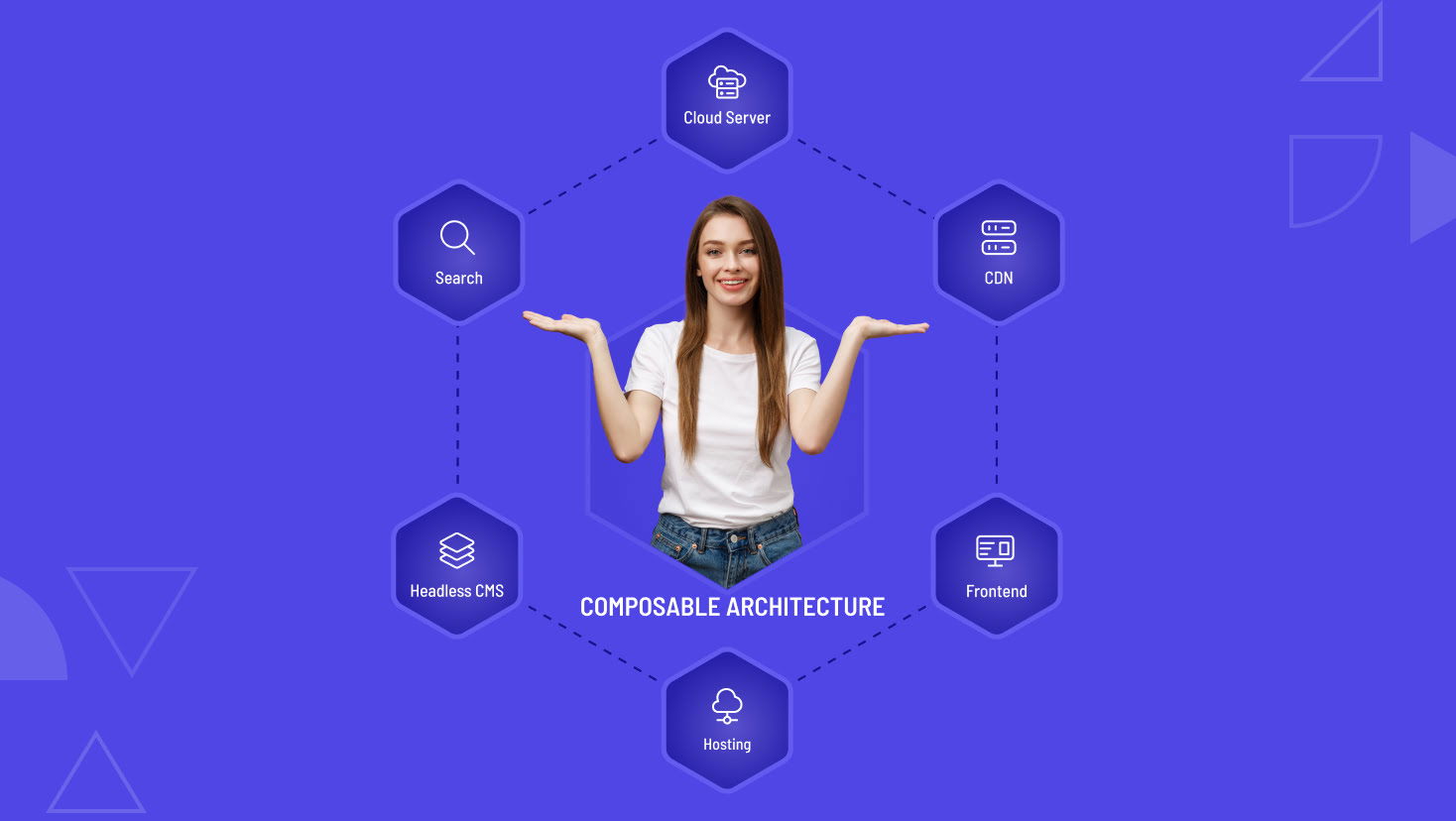
What’s Inside
- What Is Composable Architecture?
- The Role of API (Application Programming Interface) In Composable Architecture
- What Are the Key Components of a Composable Architecture?
- What Is the Difference Between Composable Architecture vs MACH?
-
What Are the Reasons to Adopt Composable Architecture? - What are the Benefits of a Composable Architecture?
- Challenges of Composable Architecture
- Want to Adopt a System that Enables Agility to Meet the Changing Market Demands?
- Is Composable Architecture the Right Choice?
- Ready to Uncover the Power of Composable Architecture?
- Conclusion
KEY TAKEAWAYS
- Composable architecture allows businesses to modularize their systems and rapidly adapt to evolving market demands.
- Composable systems reduce developer's workload and empower marketers to provide efficient results.
- Experro provides a composable architecture to build a scalable and flexible system and adapt to emerging market trends.
Transition to the era of composable architecture. But why? Here’s why...
The success of your organization doesn't depend on your current resources. It doesn't depend on size, nor does it depend on past achievements.
It's about being able to change and adapt quickly when things around you change.
In the digital realm, it refers to your system’s ability to adapt to changes in market demands and customer preferences.
Your business system should respond rapidly to changes and seize new opportunities, making it more competitive in a fast-changing environment.
Composable architecture focuses on your organization's agility and responsiveness, two key attributes that empower it to thrive in a fast-changing digital environment.
In this blog, we delve deep into its importance, exploring its core principles, benefits, and more.
Furthermore, we will uncover how businesses can leverage this architecture to reshape their systems, adapt to emerging challenges, and seize new opportunities.
What Is Composable Architecture?
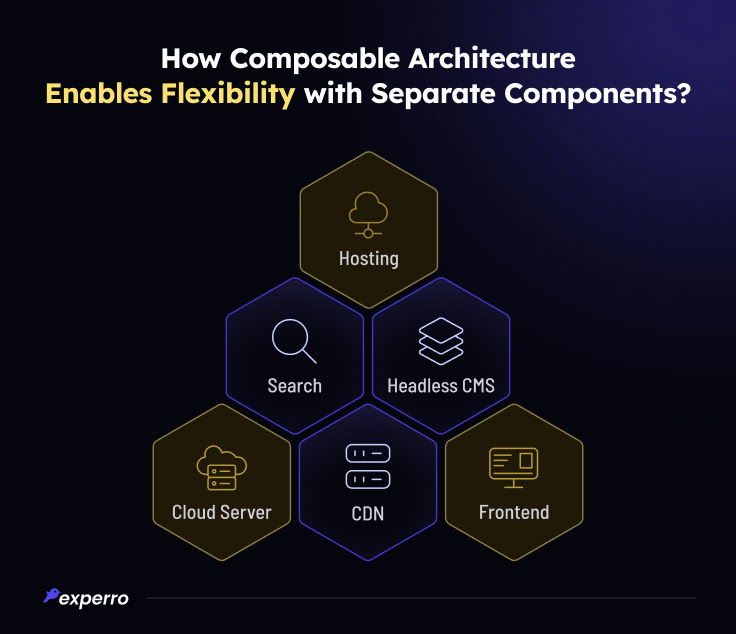
Composable Architecture definition - Composable architecture refers to building software systems that consist of separate (self-contained) modules designed to be interchangeable according to various business needs.
It breaks down complex systems into smaller, self-contained components.
By leveraging this, businesses can choose how they use components to build different things.
For example, if you run an eCommerce website and want to add a new payment method like Apple Pay, you don't have to rebuild the entire website. You can add the Apple Pay component like you're adding a new block to your structure.
It is essential because it simplifies complex system development by breaking it into smaller, reusable parts.
This modular approach offers flexibility, allowing easy adaptation and updates without disrupting the entire system.
Example of Composable Architecture
A common example of composable architecture, often emphasized by business architects, is a web application where each component is aligned with a specific function or feature.
These can include user authentication, product catalog, or payment processing, each reflecting elements of a business capability map.
These components, designed to fit into the existing architecture, are independently developed, deployable, and scalable.
They communicate through APIs to create a cohesive web application, demonstrating how different aspects of a business can be integrated seamlessly.
The Role of API (Application Programming Interface) In Composable Architecture
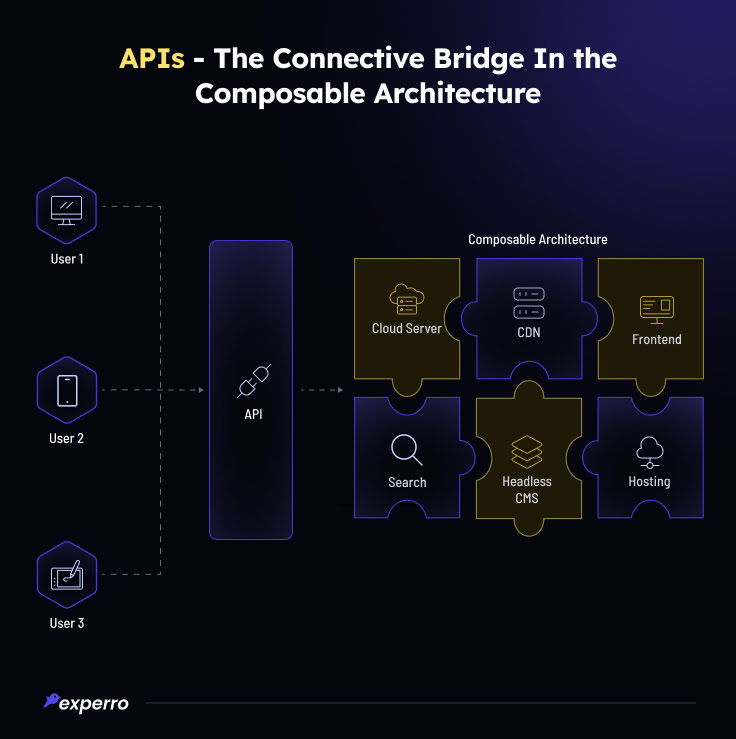
Did you know? Companies leveraging APIs have a 24% higher probability compared to those that do not utilize them.
APIs play a pivotal role in composable architecture.
They serve as the glue that enables the various components and services within a composable system to communicate and interact effectively.
APIs define the standardized interfaces and protocols that allow different components, often developed using various technologies and programming languages, to communicate seamlessly.
Moreover, through APIs, businesses can easily integrate third-party services and benefit from the new technologies.
What Are the Key Components of a Composable Architecture?
Components of a composable architecture are as follows:
1. CDN (Content Delivery Network)
CDN provides a modular solution for content delivery. It consists of a network of located servers. It scales horizontally based on ongoing demand.
As traffic increases, additional servers can be easily added to optimize performance. Additionally, CDN improves the speed of content delivery and enhances user experience.
2. Hosting
Hosting services are designed as a modular component in a composable architecture. It allows organizations to compose or recompose their infrastructure according to various business needs.
It empowers organizations to build and evolve their infrastructure while maintaining utmost scalability.
3. Headless Content Management
A headless CMS can be a valuable component, especially for managing and delivering content and data in a flexible and modular way.
There's often a need to manage a wide range of content and digital assets, including text, images, videos, and more. A headless CMS serves as the central hub for content creation, storage, and management.
4. Integration
Organizations can integrate third-party SaaS applications into their composable architecture, such as CRM systems, productivity tools, or communication services.
It allows organizations to leverage the benefits of cloud computing resources and services to enhance the flexibility, scalability, and functionality of their IT infrastructure.
What Is the Difference Between Composable Architecture vs MACH?
Composable and MACH architectures are similar concepts but share slight differences in their approaches.
Let's understand the difference from the table below:
Basis of Difference | Composable Architecture | MACH |
|---|---|---|
Meaning | A software architecture approach that emphasizes breaking down applications into small, reusable components (composable) that can be composed to create larger systems. | An architecture that focuses on four core principles: Microservices, API-first, Cloud-native, and Headless. |
| Modularity | Emphasizes modularity and reusability through composable components. | Encourages modularity but is not limited to composable components; can include microservices as well. |
| Components | Components are designed to be self-contained, with clear interfaces for composition. | Microservices are the primary components, with well-defined APIs for communication. |
| Deployment | It can be deployed in various ways, including as separate services or as part of a monolithic application. | Typically deployed as independent microservices in a cloud-native environment. |
| Flexibility | It offers flexibility in choosing technologies for different components, enabling the use of the best tool for the job. | Provides flexibility through the choice of microservices and technologies for each service. |
What Are the Reasons to Adopt Composable Architecture?
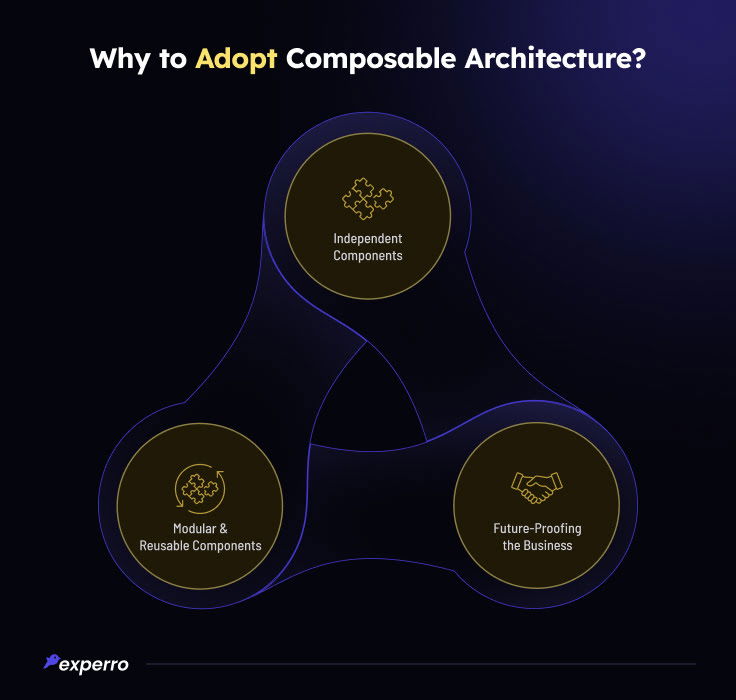
Composable architecture is the future of agile business.
Let’s find out the reasons for implementing the same from the points mentioned below:
1. Independent Components
In composable architecture, various software components are developed independently and are combined to enhance existing systems, creating a larger application.
Since each component is built for specific functionality, it aligns with clear business value, making development and maintenance more straightforward.
Components in a composable architecture are separate and do not have tight coupling with other parts of the system.
This means that changes or updates to one component do not have an impact on the entire system, which is a key advantage in agile development process.
Consider constructing a CMS using this type of a architecture.
You have distinct components for content creation, user management, and content rendering. If you decide to enhance the content creation component, you can do it independently without disrupting the entire CMS.
This isolated approach in updating or improving parts of the system ensures that the overall integrity and functionality of existing systems are maintained.
This composable approach simplifies development while reducing the risk of system-wide issues, which is a cornerstone of delivering clear business value through agile and responsive software development.
2. Modular & Reusable Components
In a composable architecture, the separate components, including multiple channels and other components, enable modularity.
This modular ecosystem, comprising a complete system, can be configured in different configurations and reused according to changing business needs, lending a competitive edge.
The modular content approach reduces the time and effort of developers since they can simply reuse the existing independent modules rather than starting from scratch.
Since they can simply reuse the existing independent modules rather than starting from scratch, it facilitates faster development, aligning with the dynamic requirements of modern business environments.
3. Future-Proofing the Business
Since composable architecture allows businesses to modify the current system simply, it future-proofs the business.
In this architecture, components function independently, akin to a virtual machine, enhancing the overall system.
As the business side grows, its technology often needs to adapt to changes.
Composable architecture makes it easy to add new components to the existing tech stack and elevate business capabilities, without disrupting the overall system.
What are the Benefits of a Composable Architecture?
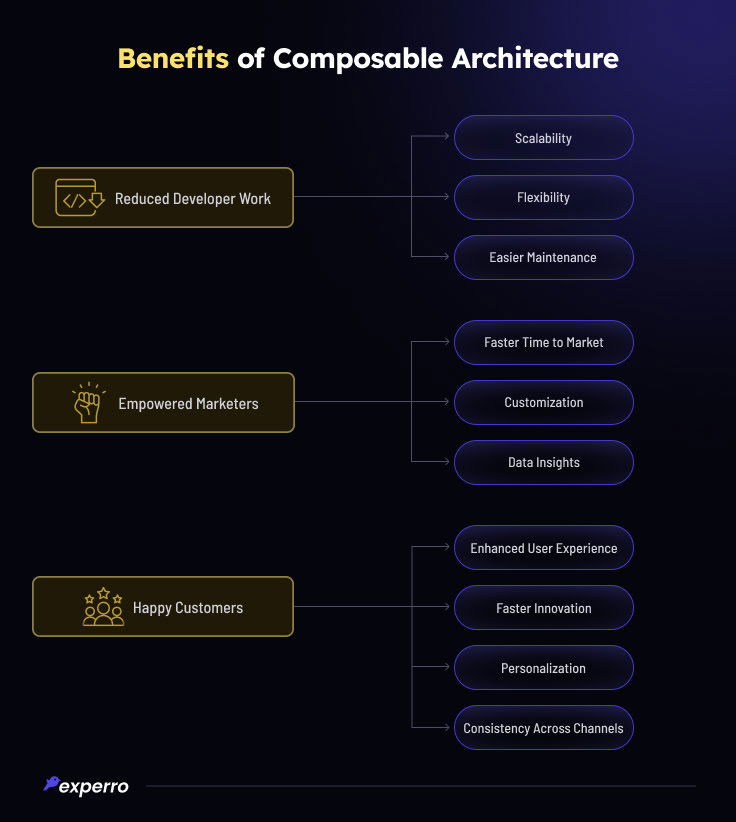
Let’s understand how composable architecture is beneficial to developers, marketers, and customers from the points mentioned below:
1. Reduced Developer Work
The following points highlight how composable architecture reduces developer’s work:
Scalability
Composable architectures often support horizontal scalability, allowing organizations to scale specific components independently based on demand.
This granular scalability ensures efficient resource utilization and cost management.
When organizations face increased workloads or growth, they can add specific components rather than scaling the entire system. This results in improved performance and cost-effectiveness.
For instance, a CMS built with composable architecture can handle increased content creation demands by scaling its content storage component, optimizing resource allocation, and controlling costs efficiently.
Flexibility
Composable architecture provides flexibility in system design and development.
It allows organizations to break down complex systems into smaller, modular components that can be assembled and reconfigured in various ways.
This flexibility means that businesses can quickly adapt to changing requirements, market conditions, and customer demands without undertaking major system changes. It fosters agility and responsiveness, enabling organizations to stay competitive.
TIP – A flexible headless CMS like Experro, allows businesses to adapt to changing market conditions and customer demands by offering composable architecture.
Easier Maintenance
Want to modify the existing system? You don’t need to re-work again from scratch. Developers can make changes to the components without affecting the whole system.
2. Empowered Marketers
Composable architecture can empower marketers and non-technical stakeholders in the following ways:
Faster Time to Market
Whether marketers want to make new campaigns live or make changes to the existing ones, they don’t need to rely on developers. Modular components empower marketers to adapt quickly to changing customer requirements.
Customization
Composable architecture allows for customization of user interfaces and user experiences.
Marketers can tailor the application's look and feel, including layouts, and themes using composable UI components and templates.
By using predefined UI components and templates, marketers can easily adjust the website's layout, color schemes, and branding elements.
For example, during a holiday season, marketers can quickly switch to a festive theme with a few clicks, providing a personalized and visually appealing shopping experience for customers.
TIP – Experro's eCommerce frontend enables marketers to create highly customized and blazing-fast storefronts.
Data Insights
Marketers can access real-time data and analytics components to gain insights into user behavior and campaign performance.
This data-driven decision-making empowers them to refine strategies and campaigns for better results.
TIP – Analytics tools enable businesses to analyze customer insights and deliver tailored solutions.
3. Happy Customers
Let’s see how composable architecture can benefit customers from the points mentioned below:
Enhanced User Experience
A total of 88% of consumers do not return to a website if they have a bad user experience.
Composable architecture, utilizing composable technologies, enables organizations to create highly customizable and flexible user interfaces within their IT infrastructure.
This approach often incorporates best of breed technologies, ensuring that customers can personalize their interactions with a product or service.
The result is a more tailored and enjoyable user experience, achieved through the seamless integration of these advanced technologies into the existing IT framework.
Faster Innovation
Composable enterprise architectures enable organizations to introduce new features and improvements rapidly.
Customers can benefit from access to the latest innovations and functionalities, and enjoy more efficient and convenient services.
Through introducing new features, over time, businesses can attract more customers.
Personalization
An interesting statistic says that 80% of consumers prefer to buy from a company that provides personalized experiences.
Composable architectures often support advanced personalization capabilities.
Organizations can use customer data to deliver personalized content, product recommendations, and services, improving customer engagement and satisfaction.
Challenges of Composable Architecture
Composable architecture is certainly the future. However, it comes with its own challenges.
Let’s explore the challenges and solutions of the same.
1. Migration
Challenge – We understand that migrating from your monolithic system might be a challenging task. Moreover, your legacy system might have tightly integrated components requiring significant redevelopment. The process can be time-consuming and overwhelming.
Solution – Experro offers a seamless migration process, providing the best support round the clock to reduce the risk to users and business processes.
2. Learning Curve
Challenge - Composable architecture may require development teams to acquire new skills and adapt to a different mindset, which can lead to a learning curve and potential productivity challenges.
Solution - Training and resources to help developers and teams get acquainted with composable architecture principles and best practices.
Is Composable Architecture the Right Choice?
Composable architecture stands at the forefront of agile software and undoubtedly is the future of the dynamic digital landscape.
It adapts seamlessly to our evolving landscape of technology and customer demand.
Especially in eCommerce business, where flexibility and responsiveness are paramount, composable architecture is definitely the right choice.
By breaking applications into components, the composable architecture allows businesses to integrate with new technology and elevate business capabilities with improved efficiency.
Conclusion
In conclusion, composable infrastructure is the future as it allows businesses to remain agile, flexible, and competitive.
When everything from market trends to customer expectations is changing, businesses must be composable.
A composable architecture framework is designed to be adaptable to modern business needs.
Book a demo with Experro to enable this forward-looking approach for your organization and witness the transformation!
FAQs


Priya Zala
13 February 2024Through her writing, she has a lovely way of capturing users' pain points and delivering solution-oriented content. Her writing is sure to captivate readers and leave them with a lasting impression. When not crafting content, Priya enjoys getting lost in a good work of fiction, which soothes her soul.